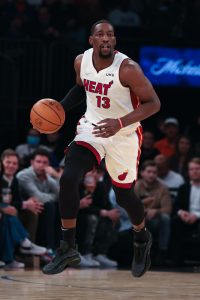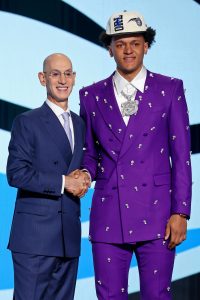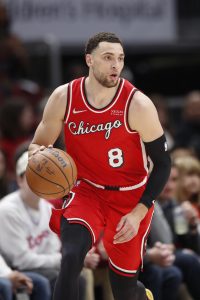Two-way contracts allow NBA teams to carry two extra players in addition to the 15 on their regular season roster. These players generally bounce back and forth between the NBA and G League, but remain under team control and can’t be poached by rival franchises.
The NBA has carried over some rule changes for two-way deals that were first introduced during the 2020/21 season. Rather than being limited to 45 days with their NBA teams, two-way players are eligible to be active for up to 50 of their team’s 82 regular season games. And instead of having their salaries determined by how many days they spend in the NBA, they’ll receive flat salaries of $508,891, half of the rookie minimum.
NBA teams have begun to fill in their two-way slots for the 2022/23 league year, so we’ll track all those deals in the space below. Some two-way players from 2021/22 inked two-year contracts and remain under contract for this season, while others have been newly signed.
If a two-way signing has been reported but isn’t yet official, we’ll list it in italics and link to the report, updating the info as necessary. Players who are in the first year of two-way contracts that cover two years (the maximum length), will be noted with an asterisk (*) once that info is confirmed.
This tracker will continue to be updated throughout the 2022/23 league year, and can be found anytime in the “Hoops Rumors Features” menu on the right-hand sidebar of our desktop site, or in the “Features” menu on our mobile site.
Here are 2022/23’s two-way players:
Updated 6-27-23
Atlanta Hawks
- Trent Forrest, G
- Empty
Boston Celtics
- JD Davison, G
- Mfiondu Kabengele, C
Brooklyn Nets
- Dru Smith, G
- RaiQuan Gray, F *
Charlotte Hornets
- Theo Maledon, G
- Xavier Sneed, F *
Chicago Bulls
- Terry Taylor, F
- Justin Lewis, F *
Cleveland Cavaliers
- Isaiah Mobley, F
- Mamadi Diakite, F/C
Dallas Mavericks
- McKinley Wright IV, G
- A.J. Lawson, G *
Denver Nuggets
- Collin Gillespie, G
- Jack White, F
Detroit Pistons
- Buddy Boeheim, G
- Jared Rhoden, G
Golden State Warriors
- Ty Jerome, G
- Lester Quinones, G
Houston Rockets
- Trevor Hudgins, G
- Darius Days, F
Indiana Pacers
- Kendall Brown, F
- Gabe York, G
Los Angeles Clippers
- Moussa Diabate, F
- Xavier Moon, G
Los Angeles Lakers
- Scotty Pippen Jr., G
- Cole Swider, F *
Memphis Grizzlies
- Vince Williams Jr., F *
- Jacob Gilyard, G *
Miami Heat
- Jamal Cain, F
- Orlando Robinson, C
Milwaukee Bucks
- A.J. Green, G
- Lindell Wigginton, G *
Minnesota Timberwolves
- Luka Garza, F
- Matt Ryan, G/F
New Orleans Pelicans
- E.J. Liddell, F *
- Dereon Seabron, G *
New York Knicks
Oklahoma City Thunder
- Olivier Sarr, C
- Jared Butler, G
Orlando Magic
- Kevon Harris, G *
- Empty
Philadelphia 76ers
- Louis King, F
- Mac McClung, G
Phoenix Suns
- Saben Lee, G
- Empty
Portland Trail Blazers
- John Butler, C
- Ibou Badji, C
Sacramento Kings
- Keon Ellis, G
- Neemias Queta, C
San Antonio Spurs
- Dominick Barlow, F
- Julian Champagnie, G/F
Toronto Raptors
- Ron Harper Jr., G/F
- Jeff Dowtin, G
Utah Jazz
- Johnny Juzang, G/F
- Micah Potter, C *
Washington Wizards
- Quenton Jackson, G *
- Jay Huff, C

 The value of those contracts depends on where a player was drafted. This year, No. 1 overall pick
The value of those contracts depends on where a player was drafted. This year, No. 1 overall pick  However, within the last 40-ish hours, 40 of the players from our list of
However, within the last 40-ish hours, 40 of the players from our list of  Of the eight other players listed above, four are restricted free agents, which will reduce their leverage to negotiate favorable multiyear terms, at least to some extent. However, Ayton, in particular, still seems like a good bet to land a lucrative long-term contract.
Of the eight other players listed above, four are restricted free agents, which will reduce their leverage to negotiate favorable multiyear terms, at least to some extent. However, Ayton, in particular, still seems like a good bet to land a lucrative long-term contract.
 Listed below are the maximum-salary contracts for players signing contracts that start in 2022/23.
Listed below are the maximum-salary contracts for players signing contracts that start in 2022/23.